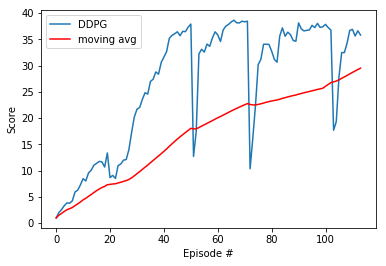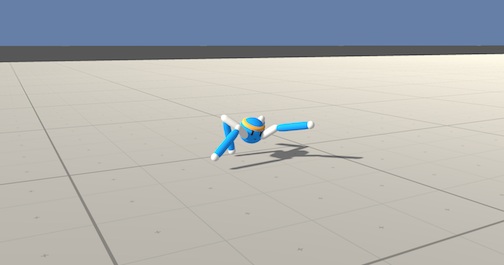For this project, you will work with the Reacher environment.
In this environment, a double-jointed arm can move to target locations. A reward of +0.1 is provided for each step that the agent's hand is in the goal location. Thus, the goal of your agent is to maintain its position at the target location for as many time steps as possible.
The observation space consists of 33 variables corresponding to position, rotation, velocity, and angular velocities of the arm. Each action is a vector with four numbers, corresponding to torque applicable to two joints. Every entry in the action vector should be a number between -1 and 1.
In order to solve the environment, the agent must achieve a score of +30 averaged across all 20 agents for 100 consecutive episodes.
- Set-up: Double-jointed arm which can move to target locations.
- Goal: Each agent must move its hand to the goal location, and keep it there.
- Agents: The environment contains 20 agents linked to a single Brain.
- Agent Reward Function (independent):
- +0.1 for each timestep agent's hand is in goal location.
- Brains: One Brain with the following observation/action space.
- Vector Observation space: 33 variables corresponding to position, rotation, velocity, and angular velocities of the two arm Rigidbodies.
- Vector Action space: (Continuous) Each action is a vector with four numbers, corresponding to torque applicable to two joints. Every entry in the action vector should be a number between -1 and 1.
- Visual Observations: None.
- Reset Parameters: Two, corresponding to goal size, and goal movement speed.
- Benchmark Mean Reward: 30
Following steps are taken in building an agent that solves this environment.
- Evaluate the state and action space.
- Establish performance baseline using a random action policy.
- Select an appropriate algorithm and begin implementing it.
- Run experiments, make revisions, and retrain the agent until the performance threshold is reached.
The state space space has 33 dimensions corresponding to the position, rotation, velocity, and angular velocities of the robotic arm. There are two sections of the arm — analogous to those connecting the shoulder and elbow (i.e., the humerus), and the elbow to the wrist (i.e., the forearm) on a human body.
Each action is a vector with four numbers, corresponding to the torque applied to the two joints (shoulder and elbow). Every element in the action vector must be a number between -1 and 1, making the action space continuous.
The barrier for solving the environment is to take into account the presence of many agents. In particular, the agents must get an average score of +30 (over 100 consecutive episodes, and over all agents). Specifically,
- After each episode, we add up the rewards that each agent received (without discounting), to get a score for each agent. This yields 20 (potentially different) scores. We then take the average of these 20 scores.
- This yields an average score for each episode (where the average is over all 20 agents). The environment is considered solved, when the average (over 100 episodes) of those average scores is at least +30.
The chosen algorithm is outlined in this paper, Continuous Control with Deep Reinforcement Learning, by researchers at Google Deepmind. In this paper, the authors present "a model-free, off-policy actor-critic algorithm using deep function approximators that can learn policies in high-dimensional, continuous action spaces." They highlight that DDPG can be viewed as an extension of Deep Q-learning to continuous tasks.
I used this vanilla, single-agent DDPG as a template. I further experimented with the DDPG algorithm based on other concepts covered in Udacity's classroom and lessons. My understanding and implementation of this algorithm (including various customizations) are discussed below.
Once all of the various components of the algorithm were in place, the agent was able to solve the 20 agent Reacher environment. Again, the performance goal is an average reward of at least +30 over 100 episodes, and over all 20 agents.
The graph shows that after 20, 50, 70 and 100 epsisodes the training was interrupted and continued after reloading the network's data.
For this project, we will provide you with two separate versions of the Unity environment:
- The first version contains a single agent.
- The second version contains 20 identical agents, each with its own copy of the environment.
The second version is useful for algorithms like PPO, A3C, and D4PG that use multiple (non-interacting, parallel) copies of the same agent to distribute the task of gathering experience.
-
Download the environment from one of the links below. You need only select the environment that matches your operating system:
-
Version 1: One (1) Agent
- Linux: click here
- Mac OSX: click here
- Windows (32-bit): click here
- Windows (64-bit): click here
-
Version 2: Twenty (20) Agents
- Linux: click here
- Mac OSX: click here
- Windows (32-bit): click here
- Windows (64-bit): click here
(For Windows users) Check out this link if you need help with determining if your computer is running a 32-bit version or 64-bit version of the Windows operating system.
(For AWS) If you'd like to train the agent on AWS (and have not enabled a virtual screen), then please use this link (version 1) or this link (version 2) to obtain the "headless" version of the environment. You will not be able to watch the agent without enabling a virtual screen, but you will be able to train the agent. (To watch the agent, you should follow the instructions to enable a virtual screen, and then download the environment for the Linux operating system above.)
-
-
Place the file in the DRLND GitHub repository, in the
p2_continuous-control/folder, and unzip (or decompress) the file.
Follow the instructions in Continuous_Control.ipynb to get started with training your own agent!
After you have successfully completed the project, you might like to solve the more difficult Crawler environment.
In this continuous control environment, the goal is to teach a creature with four legs to walk forward without falling.
You can read more about this environment in the ML-Agents GitHub here. To solve this harder task, you'll need to download a new Unity environment. (Note: Udacity students should not submit a project with this new environment.)
You need only select the environment that matches your operating system:
- Linux: click here
- Mac OSX: click here
- Windows (32-bit): click here
- Windows (64-bit): click here
Then, place the file in the p2_continuous-control/ folder in the DRLND GitHub repository, and unzip (or decompress) the file. Next, open Crawler.ipynb and follow the instructions to learn how to use the Python API to control the agent.
(For AWS) If you'd like to train the agent on AWS (and have not enabled a virtual screen), then please use this link to obtain the "headless" version of the environment. You will not be able to watch the agent without enabling a virtual screen, but you will be able to train the agent. (To watch the agent, you should follow the instructions to enable a virtual screen, and then download the environment for the Linux operating system above.)


